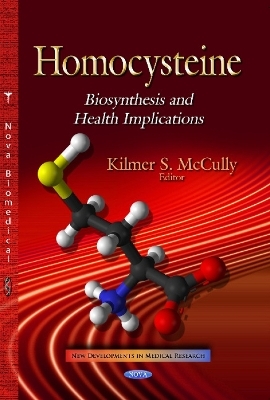In the aftermath of the discovery of the essential amino acid methionine in 1922, a new sulphur amino acid was discovered a decade later by Vincent DuVigneaud as a product of the degradation of methionine. This new amino acid, homocysteine, was found to be an important intermediate compound in the metabolism of methionine, cysteine and other sulfur amino acids through studies in animals. Although methylation reactions and one carbon metabolism were found to be related to the metabolism of homocysteine, little was known of the biomedical significance of this obscure sulphur amino acid in the 1950s. The studies of children with mental retardation, dislocated optic lenses, osteoporosis and other skeletal abnormalities, and a propensity for arterial and venous thrombosis, revealed the new inherited disease homocystinuria in 1962. A new concept of the importance of homocysteine in human disease was developed after the chance observation of rapidly advancing arteriosclerosis in children with different inherited enzymatic abnormalities of homocysteine metabolism by Kilmer McCully in 1969. This concept led to the development of the Homocysteine Theory of Arteriosclerosis, which stimulated an extraordinary effort to understand the importance of homocysteine in human disease by investigators in laboratories and clinics worldwide. As a result of over 17,500 published investigations in subsequent years, the obscure sulphur amino acid homocysteine was elevated to the status of "the cholesterol of the 21st century" because of its prominent involvement in human vascular disease. Extensive human studies identified the elevation of plasma homocysteine as a potent, independent risk factor for vascular disease, including coronary heart disease, cerebrovascular disease, and peripheral vascular disease. Many other important human diseases were subsequently found to be affected by homocysteine, as described by the authors of several chapters in the present book. These diseases, many of which are correlated with ageing, include neurodegenerative diseases and dementia, epilepsy, uremia, osteoporotic fractures, anaemia of renal failure, infection by HIV+, glaucoma, macular degeneration, bariatric surgery for obesity, celiac disease and psoriasis.
Preface; Enzyme Misfolding as a Common Pathogenic Mechanism in Cystathionine Beta-Synthase (CBS)-Deficient Homocystinuria: Rescue of CBS Mutants with Chemical Chaperones; Therapeutic Strategies in Murine Models of Hyperhomocysteinemia; Homocysteine & Neurodegeneration: Current Concepts & Potential for Intervention; Homocysteine & Apoptotic Factors in Epileptic Patients Treated with Anti-Epileptic Drugs; Homocysteine & Uremia; Homocysteine: An Innovative Risk Factor for Anemia, Bone Disease & Vascular Disease in Chronic Renal Failure Patients; Plasma Homocysteine & Thiol Redox States in HIV+ Patients; Hyperhomocysteinemia & Association of Eye Disease; Homocysteine Concentrations in Obese Patients after Biliopancreatic Bypass Surgery; Celiac Disease, Hyperhomocysteinemia & Atherothrombosis: Relationship & Implications; Homocysteine Metabolism, Cardiovascular Disease & Psoriasis; Index.



